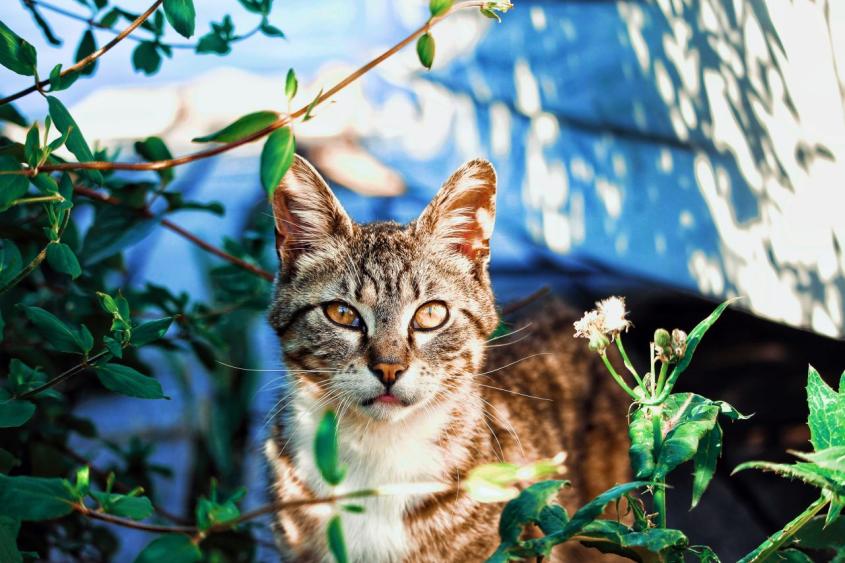Reducing the risks of zoonotic disease transmission through responsible cat ownership
Cats have a special place in many people’s hearts. An estimated 60 million felines are kept as pets in the United States alone. Cats also occupy a distinct position in the ecological networks of companion animals, humans and peri-domestic species – wild and feral animals living near human habitations – according to a recent review article by a team of Cornell researchers from the Departments of Public and Ecosystem Health and Microbiology and Immunology.
More than most companion animals, “many cats have two lives – in close contact with people at home, but also with animals outside,” said Gary Whittaker, the James Law Professor of Virology and co-author of the article, which appeared in Science Translational Medicine in October. Outdoors, they interact with wildlife and each other, including with a growing number of feral cats. As urbanization increases, so do the interactions – and with them, the likelihood that zoonotic diseases, infections that are spread between animals and people, are transmitted.
"While the studies of zoonotic diseases have been historically focused on farm animals, and food-borne diseases in particular, there is very limited knowledge on the role of companion animals, notably cats, in disease transmission to people,” said Amandine Gamble, D.V.M. ’15, Ph.D. ’18, assistant professor in disease ecology in the Department of Public and Ecosystem Health and the article’s lead author. This is a gap Gamble and her co-authors hope to begin to fill, applying a One Health perspective – which recognizes the interdependent nature of human, animal and ecosystem health – to list a number of diseases in which cats and other companion animals play an important role.

Interspecies transmissions
Rabies transmitted by unvaccinated cats currently poses the greatest threat. “People associate rabies with dogs, but I think more and more cats are becoming a source of rabies for humans,” Whittaker said. Caused by a rhabdovirus that affects the central nervous system, the disease is nearly always fatal if left untreated before clinical symptoms begin. “Maintaining your cat’s rabies vaccination schedule is challenging for many people, but it’s very important,” Whittaker said. The risk of rabies is a good reason to keep cats indoors or in a controlled environment such as an enclosed patio (“catio”) that prevents contact with other animals, particularly feral cats, which are difficult to vaccinate.
Companion animals also serve as bridges between otherwise unrelated species for other infections. Yersinia pestis, the bacterium that causes the plague, for instance, is present in pockets of seventeen western states in the United States. “Cats can be a very good conduit for the disease to humans, because they come in contact with the rodents that are reservoirs,” Whittaker explained. Other domesticated animals can cause issues, too. For example, some horses in Australia interact with fruit bats that carry the Hendra virus. Passed on to attending veterinarians or other humans, the virus can cause severe disease.

In other cases, companion animals help spread diseases geographically or provide opportunities for their further evolution. Coronaviruses exist in numerous different animal species, including cats, dogs and horses. A new, recombinant feline-canine coronavirus hybrid has been making its way through large and unmanaged feral cat colonies in Cyprus. Because the animal coronaviruses can sometimes infect humans, they represent a tangible risk.
In the case of the protozoal parasite Toxoplasma gondii, cats contribute to maintaining the zoonotic pathogen. “Cats are the definitive host for toxoplasmosis,” said Bruce Kornreich, D.V.M. ’92, Ph.D. ’05., director of the Cornell Feline Health Center. The risk of infection directly from cats is small, though anyone who is pregnant should avoid emptying a cat litter box, as toxoplasmosis can have severe consequences for the developing fetus. Cats play a more critical role in keeping the parasite present in the environment. Their feces may contaminate vegetables in a garden or be ingested by pigs or cows that pass the parasite on in undercooked meat.

Pets as sentinels
“It is very important to understand the role that companion animals play in this kind of chain of infection,” Kornreich said. “The more knowledge we have, the more strategic we can be in taking measured, educated and coordinated steps to address these issues as they arise.” The first requirement, he says, will be to better monitor pets and peri-domestic species and note changes in the biology of various microorganisms and their virulence, the spread between species, and the mode of transmission. Thereby companion and peri-domestic animals can act as sentinels, helping with early detection of diseases in human populations when increased animal cases are found.
Whittaker acknowledges that solutions will not always be straightforward when it comes to cats. “Cats are wonderful companion animals – and they can also act like an invasive species, as we see in Australia, for example,” he said. “So we have to find a balance of responsible pet ownership.” Whittaker encourages owners to keep cats indoors whenever possible, and he advocates strongly for managing feral cat populations, though the best method is still up for debate. “It’s hard, and we need to consider a range of viewpoints about this problem,” he said.
Indeed, given the complex nature of zoonotic disease transmission, any solution will require an equally multifaceted approach. “We don’t want to jump to conclusions but bring together fairly different sets of individuals to look at the problem,” Kornreich said. “It’s really important that veterinarians, medical professionals, conservationists, and policymakers all work together to achieve the best outcome for the health of people, animals and the environment.”
Written by Olivia Hall





